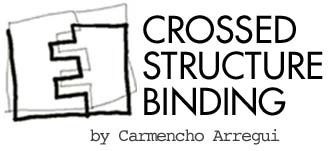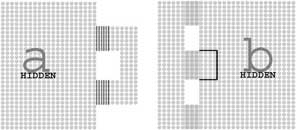

CROSSED STRUCTURE BINDING HIDDEN
Click here to see CSB images.
There is no need for additional decoration on this clean, minimal binding. The straps disappear and the crossing of the parts remains hidden until the secret is revealed.
CSB Hidden
I will assume that the book is ready to be bound and that all prior steps have been carefully carried out. The description refers to a full-leather binding with clean-cut edges (handmade paper, parchment and vellum can also be used). I will not work to any particular dimension, assuming the template to be clear enough for each person to adapt it to a given size.
Cutting the back cover
The two sides of the cover are cut separately.
Cut the back cover following side a of the template.
The back has two parts: the back cover itself, and an extension in which a window has been cut. This extension can be different sizes and may carry the title of the book. Its structural function, however, is to hide the link of the loose central flap of the front cover.
The sewing
To see the fixing of the cover to the sewing frame go to A sewing frame in the index.
The book-block is sewn to the two 'bridges' of the extension; which are a bit longer than the estimated thickness of the spine.
The sewing is carried out with kettle stitches in the normal way. To see sewing 1, go back to CSB sewings in the index. After the sewing, the spine is still accessible and can be lined if desired. The thickness of the thread should provide enough 'swell' in the spine to allow you to round the book. I always round by hand, not with a hammer.
Cutting the front cover
The front cover should not be prepared until you know the exact thickness of the spine.
After sewing, cut the front cover following side b of the template.
The front cover includes the cover itself, the spine and a panel that will be fixed to the back cover after the crossing has been done.
Cut two 'windows' on the spine for the exposed sewing, and then cut the central flap between the two windows following side b of the template. The end of this flap will be hidden by the extension of the back cover.
The crossing
The crossing of the CSB Hidden is a bit tricky: after cutting the front cover, insert the extension of the back cover (which is lying over the front endpaper) under the central flap of the front cover (it goes under the front cover but comes out through the cut of the central flap). In this way the front cover will lie between the extension and the front endpaper.
The panel of the front cover is taken to the back, the two windows at the spine framing the exposed sewing. The central flap will naturally come forward between the sewing stations and, as in a puzzle, will fill the gap.
The panel of the front cover is then fixed to the back cover.
To keep the central flap on the front cover in place, the area around it (or the whole front cover) can be lined with Japanese paper. The flap's joint is hidden by the extension of the back cover on the outside and inside is concealed by the endpaper.
To consolidate the book, put a heavyweight paper between the leather and the endpapers, and then put the binding between pressing boards under a weight.
This hidden structure must be carefully calculated and making a dummy might prove useful.
If you want to download the text, templates and sewings of this binding, go to Download CSB in the index.